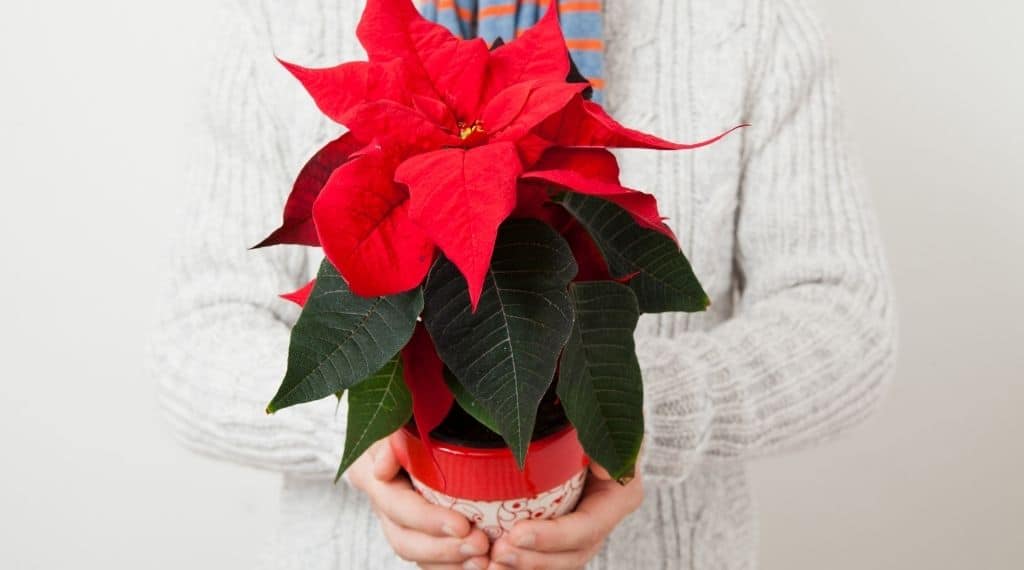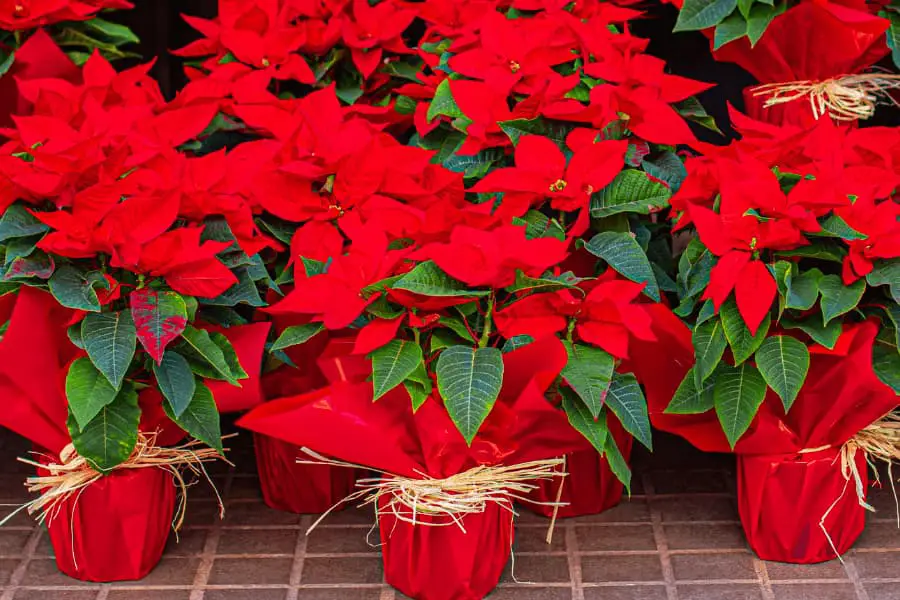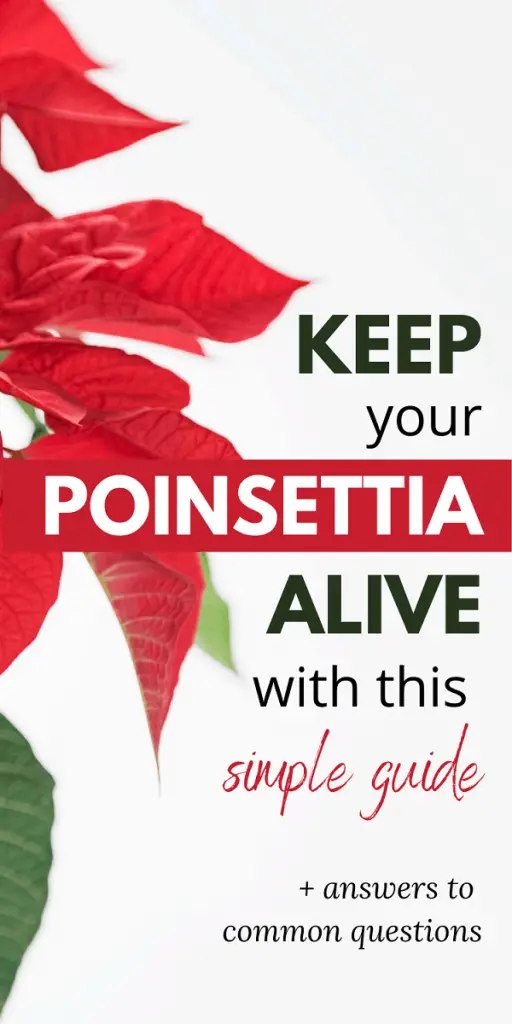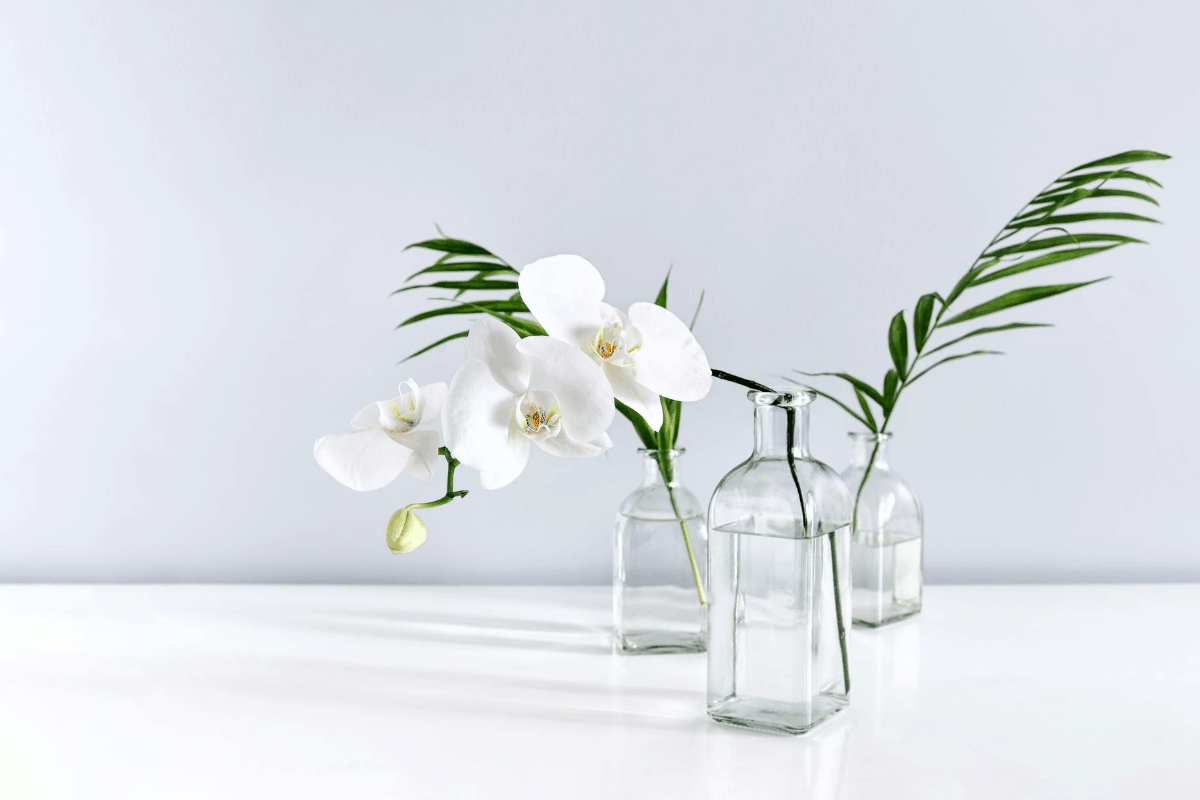Last Updated on October 5, 2021 by Plantiful Interiors
Keep Your Poinsettia Alive After Christmas
Nothing says it’s the Christmas season quite like a Poinsettia.
A plant so synonymous with Christmas it could rival a Douglas Fir tree. The humble Poinsettia appears in homes all across the world in December, bringing festive warmth with it over the holidays.
Those captivating, star-shaped red leaves contrasting the plant’s dark green leaves remind us that the holidays are either just around the corner or are wrapping up.
They make the perfect merry little gift, can bring festive cheer to the center of any dining table, and can give your friends and family a warm welcome as they enter your home throughout the holidays.
But did you know, your Poinsettia doesn’t need to be thrown out with the wrapping paper after you’ve finished celebrating with your loved ones?
By learning how to care for your poinsettia, you can keep your poinsettia plant alive long after Christmas. You may even be able to save your poinsettia for next year.
Let’s take a closer look at how to care for a Poinsettia plant, so you can keep this glorious little plant alive long after your last guest has gone home after the Christmas holidays.
This site features affiliate content. As an affiliate partner of various brands, we earn commissions on qualifying purchases, at no extra cost to you. Please read our disclaimer for more information.
How to Keep A Poinsettia Alive And Bloom Again
A Poinsettia plant is not just for Christmas; with the correct care and attention, your festive little friend can bloom the following year.
So let’s have a look at how to keep your Poinsettia alive and healthy, so you can enjoy it again and again.
November – May
- Purchase your Poinsettia using the buying guide below
- Place your Poinsettia in an area where it will get bright indirect light
- Keep your Poinsettia away from drafts
- Keep your Poinsettia in a room that is between 65-75 degrees Fahrenheit
- Water once per week or when the top 2 inches of soil is dry to the touch and the pot feels light – use room temperature water
April – June
- Reduce watering in Spring (April) when leaves begin falling off
- Cut back main stems to 4-6 inches above the soil in the Spring
- Repot your Poinsettia in the Spring after cutting it back
- Plant in well-draining soil
July – October
- Pinch back stems again in Summer (July)
- Late fall (October), reduce the amount of sunlight, place in darkness for at least 12 hours/day
- Watch for buds to start forming (October – November)
- Return to weekly watering and leave in bright indirect sunlight
Keep reading for more in-depth Poinsettia care instructions
When To Buy a Poinsettia
According to Random Acts Of Flowers, Americans buy over 35 million Poinsettia plants every year, with most people buying them in December, just before Christmas.
However, Poinsettias are already at their best and ready to brighten up your home even before Thanksgiving. The best time to buy a Poinsettia is mid-November, you’ll avoid the crowd, be able to have your pick of the litter and enjoy it’s vibrant colors for it’s full blooming cycle.
Poinsettia plants can happily continue to bloom until February, meaning that you might even get to enjoy their bold, red flowers for Valentine’s Day.
With a little extra attention, your Poinsettia plant can last until next year – it’s the gift that keeps on giving!
What To Look for When Buying a Poinsettia
Fun fact: the red “flowers” that characterize the Poinsettia aren’t really flowers at all!
They’re actually a cluster of leaves known as a “bract” that has turned from green to red.
However, the plant does indeed also have flowers, which are small, yellow, berry-like buds found in the center of each bract.
Since poinsettias come in a variety of colors, you’re sure to find one that matches your decor. Choose from red, white, pink and even orange versions of this stunning Christmas plant favorite.
Making sure you buy a healthy Poinsettia will give you a long-lasting plant to enjoy throughout the winter, and will give you a better chance to keep your Poinsettia alive so that you can enjoy it as long as possible.
Poinsettia Buying Guide
Here’s what to look for when buying a Poinsettia:
- the plant should already have a lot of bracts (fully-colored leaves) when you buy it
- the yellow flowers should be partially opened or just starting to open
- the plant shouldn’t have many yellowed leaves
- the plant should not be displayed in a cool drafty area
Poinsettia plants are often wrapped in foil when you buy them, but if you can, peel back a little of the foil to get a better look at the plant. You want to check the lower foliage and soil to make sure you’re buying a healthy plant.
The soil shouldn’t be dripping wet, nor bone dry, and the plant should have lots of healthy-looking green leaves on the lower parts.
Yellow leaves are often a sign that your plant has been either over-watered or under-watered, and may cause more leaves to fall off once you’ve brought the plant home.
A top tip from the website HouseBeautiful is to see where the plant is placed before you buy it. Poinsettias don’t like the cold or drafts, so if the plants are sat next to a set of doors that open frequently (like at the entrance to a store), they could already be suffering.
If you live somewhere particularly cold, it’s especially important to buy Poinsettia plants from a store that has kept them in a warm place, out of the wind, and any cold breezes.
Poinsettia Care – Answers to Common Questions
How Much Water Does A Poinsettia Need?
Native to Mexico, these plants like it warm and not too wet.
During its blooming cycle, you’ll likely need to water about once per week. A quick touch of the soil will tell you when it’s time to water. Dig your finger just slightly into the soil (about 1 inch). If the soil is dry to the touch just beneath the surface it’s time to water.
To avoid shocking your poinsettia, use room temperature water.
Over-watering is a common mistake and can lead to root-rot and leaf-dropping.
Having good drainage is key to avoiding over-watering, so make sure you use loose soil and a container with multiple holes at the bottom. If your plant came wrapped in foil and you plant to leave it this way, poke holes in the bottom to allow for proper drainage.
If your plant is sitting on a tray or saucer, make sure you always empty any excess water to stop the plant from sitting in too much liquid.
If you plan to keep your poinsettia year round, around February, or when the leaves start to turn yellow and fall off, don’t be concerned. Cut back the amount of water you give your plant. The dormancy period typically lasts until late April – early May. Once the dormancy period ends you’ll start to see new life in your plant and can gradually increase to regular watering again.
How Much Light Does A Poinsettia Need?
Your Poinsettia wants to be reminded of its home of Mexico as much as possible, so it will love sitting on a windowsill where it can get as much bright, yet indirect sunlight as possible during its bloom cycle.
Take caution though, if your plant is right next to a window, don’t let its leaves touch the glass, as the cold can cause the leaves to drop and the plant to wither. You’ll also need to make sure that your window is not creating a draft which can also be damaging to your Poinsettia.
Poinsettias are “short day” plants so they are affected by the amount of sunlight they receive each day.
Once re-potted in Spring, it’s best to move your plant outside into a partially-shaded spot. Check out this informative article about short-day plants to find out more.
When Should I Repot My Poinsettia Plant?
While your plant will probably last the holiday season without needing to be re-potted, if you want to keep it healthy and ready for next year, you’ll need to transplant it into a slightly bigger container in the Spring.
Transfer your Poinsettia to a pot that is 2 to 4 inches larger than the one the plant came in, with a good amount of drainage holes.
Take the plant out of its original pot and loosen the soil around it, then plant it in the new container at the same height as it was stood before.
Pat the soil down around the base of the plant and water.
In order to start getting it ready for the following year, you’ll need to start reducing its water intake slowly from around April.
For a more in-depth guide on re-potting, and how to keep your Poinsettia alive year-round, check out this article by The Spruce.
What Type Of Soil Should I Plant My Poinsettia In?
Like any other house plant, your Poinsettia needs the right soil to flourish.
An organic, loose, well-draining soil with peat moss mixed in is an excellent choice. Try Burpee Organic Premium Potting Mix.
Poinsettias like a pH level of between 5.5 and 6.5, which is considered neutral, so you don’t want a very acidic or alkaline soil.
What Temperature Can Poinsettias Tolerate?
These little guys like it warm and will be fine in a heated house during the holidays. Poinsettias do well in temperatures around 68 – 75 degrees Fahrenheit.
If you are hoping to keep your plant year-round, it’s ok to place it outside in the spring. However, if you live in a particularly cold area, you’ll need to move the plant back indoors if temperatures at night drop below 60 degrees Fahrenheit.
Temperature is a very important part of your Poinsettia care. Remember to keep your Poinsettia plant away from any drafty windows or air vents.
When Should I Cut Back My Poinsettia?
In order to get your Poinsettia plant to bloom again the following year, pruning is crucial.
In spring (April – May), as the colored leaves have started to diminish and you’re preparing to repot your Poinsettia, cut the stems back to about 4 to 6 inches above the soil to encourage regrowth.
Then, in summer (around July), it will be time to pinch back the stems again, but this time only by about 1/2 – 1 inch. If you don’t follow this step, your plant will grow back long and leggy.
To see the process up close, check out this brief video that walks you through the Poinsettia pruning step by step:
When Will My Poinsettia Bloom Again?
After you’ve followed the pruning tips above, a key trick to getting your poinsettia to bloom again is keeping it in the dark at specific times. This is a technique that is specific to short-day plants and will dictate whether or not your plant will flower the second time around.
Around October, you should reduce the amount of sunlight the plant receives to less than 12 hours a day. When you want the plant to stop getting sunlight, move it into a completely dark area from late afternoon until the morning with absolutely no source of additional light.
Do this daily for 8 to 10 weeks, or at least until the end of November and you should start seeing new buds forming.
In early December, you should be seeing plenty of new flower buds. At this point, the flowers and bracts should be in full force, ready for another Christmas with your family.
Treat the plant as you did when it first arrived in your home from the store or garden center, and repeat the process the following year to ensure your Poinsettia blooms again and again.
But Wait…..Didn’t I Hear Somewhere That Poinsettias are Poisonous?
While it’s true that Poinsettias are not the tastiest treat for your children or pets, and may give them a little stomach upset, Poinsettias being poisonous is a myth.
The plant contains a milky sap which can cause mild irritation and shouldn’t be ingested, but it is not any more dangerous than that.
The reputation for being toxic came from a story in 1919 when American authorities misclaimed a child’s cause of death as being ingested of a Poinsettia plant.
This led to years of misinformation, but the myth was finally debunked when the American Association of Poison Control Centers (AAPCC) conducted a 20-year study that concluded the sap of the plant was not poisonous.
Ready To Keep Your Poinsettia Healthy?
Hopefully, you have all of your poinsettia care questions answered now and are feeling much more confident in your ability to keep a poinsettia alive.
These little plants are colorful, versatile and can be showcased both indoors and out.
We’d love to hear how your poinsettia is doing, drop us an update in the comments below.
Looking for more plants to keep your house fresh and vibrant year round? Check out these articles:
5 Insanely Easy Flowering Houseplants
Low Maintenance Indoor Plants For Beginners
Indoor Plant Care Tools To Keep Plants Healthy






